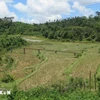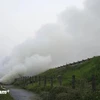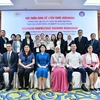Vice National Assembly Chairman Nguyen Duc Kien has emphasised the need to combine the State budget and producers’ capital, as well as mobilise producers in preserving the environment.
At a working session with the Hanoi People’s Committee on the implementation of environmental policies and law at craft villages in the city, Vice NA Chairman Kien expressed his support for Hanoi ’s selection of pilot models to draw experiences for expansion.
However, he laid stress on publicising and defining authorities’ and people’s responsibility in environmental protection as well as the clarity in the city’s instruction documents in terms of time for implementation.
According to the committee’s report, the city is now home to 1,350 craft villages, including 198 traditional craft villages. The villages have attracted more than 672,000 workers with 170,607 production families, 2,063 joint stock companies, more than 4,560 Ltd. Co., over 1,460 private businesses, 164 cooperatives and 50 associations.
In 2010, craft villages’ total production value was estimated at more than 8.6 trillion VND, making up 8.3 percent of the industrial production value of the city.
The waste volume discharged from craft villages has increased, together with the expansion and development of craft villages’ business production.
In the meantime, shortcomings remain in environmental management at craft villages and due attention has not yet been paid to treatment of craft village waste.
To ease the situation, Hanoi has carried out solutions to reduce environmental pollution at craft villages and built a pilot waste water treatment system at the cassava craft villages in Tan Hoa commune, Quoc Oai district.
The city has also zoned off 2,580 ha for accommodating establishments causing pollution in craft villages and 1,424 ha for developing clusters of craft villages.
It has so far built 47 industrial clusters on 2,648 ha which attracted 2,360 investment projects./.
At a working session with the Hanoi People’s Committee on the implementation of environmental policies and law at craft villages in the city, Vice NA Chairman Kien expressed his support for Hanoi ’s selection of pilot models to draw experiences for expansion.
However, he laid stress on publicising and defining authorities’ and people’s responsibility in environmental protection as well as the clarity in the city’s instruction documents in terms of time for implementation.
According to the committee’s report, the city is now home to 1,350 craft villages, including 198 traditional craft villages. The villages have attracted more than 672,000 workers with 170,607 production families, 2,063 joint stock companies, more than 4,560 Ltd. Co., over 1,460 private businesses, 164 cooperatives and 50 associations.
In 2010, craft villages’ total production value was estimated at more than 8.6 trillion VND, making up 8.3 percent of the industrial production value of the city.
The waste volume discharged from craft villages has increased, together with the expansion and development of craft villages’ business production.
In the meantime, shortcomings remain in environmental management at craft villages and due attention has not yet been paid to treatment of craft village waste.
To ease the situation, Hanoi has carried out solutions to reduce environmental pollution at craft villages and built a pilot waste water treatment system at the cassava craft villages in Tan Hoa commune, Quoc Oai district.
The city has also zoned off 2,580 ha for accommodating establishments causing pollution in craft villages and 1,424 ha for developing clusters of craft villages.
It has so far built 47 industrial clusters on 2,648 ha which attracted 2,360 investment projects./.



















